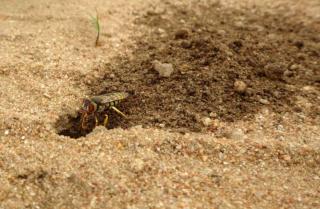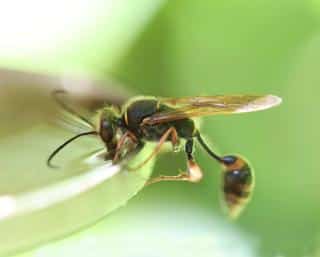

As soon as the word wasp is mentioned, we all shudder at the thought of that insect that somehow always finds ways to turn a nice family picnic into a frenzied gaggle of panicked people! But did you know there were a great many wasp varieties? One of which is particularly interesting: the predator wasp.
As its name shows, this flying insect that’s part of the Hymenoptera order is an accomplished hunter that feeds on many pests. Seize the chance to learn more about this unexpected beneficial garden animal! Read also:
The predator wasp has a different bearing and silhouette depending on the species it belongs to. However, they all have one thing in common: the joining point between the thorax and abdomen is extremely thin. Adult specimens usually measure less than an inch (a few dozen millimeters), and their appearance is often black, tinted with yellow and red.
Just like the mason bee, every predator wasp is a solitary insect that builds its own nest to house its offspring. However, before laying its eggs, each cell is filled with prey that stays dormant thanks to a paralyzing venom. These insects are a store of food for the hatching larva to feed on. At the end, eggs are laid and the cell is closed up.

The wasp’s habitat depends on the species:
Individual adults feed on nectar, they play a small part as pollinators. Much more relevant are the larvae which are carnivorous, they consume a great many paralyzed insects as they grow. Each wasp species specializes in one or more types of prey. For instance, they might hunt aphids, smooth-skinned caterpillars (bollworm, geometer moth, etc.), larvae, leafhoppers, beetles of all types (like jewel beetles), weevils, spiders… the list is endless!
Even though it’s a formidable predator, such wasps are rarely capable of stopping a sudden invasion of pests and parasites. Luckily, their constant feeding pressure helps control pest populations, minimizing risks of such infestations and benefiting your plants in the most natural way possible.

Both a pollinator and a pest regulator, the predator wasp shares these two benefits to help us as we work in the garden and vegetable patch.
Read also: